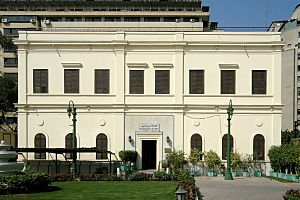Institut d'Égypte facts for kids
The Institut d'Égypte, also known as the Egyptian Scientific Institute, is a special group in Cairo. It focuses on studying Egyptology, which is the study of ancient Egypt.
This institute was started in 1798 by Napoleon Bonaparte. He created it to help with research during his campaign in Egypt. It is the oldest scientific institute in Egypt. Sadly, its building burned down in 2011 during the Arab Spring protests. Many important documents were lost. But the institute reopened in December 2012.
Contents
How the Institute Started
Napoleon Bonaparte founded the Institut d'Égypte on August 22, 1798. Its main goal was to bring new ideas and knowledge to Egypt. It was part of a larger French group called the Institut de France.
Sections of Study
The institute was organized into different sections. These sections covered many important topics. They included:
- Mathematics
- Physics and natural history
- Political economy (how countries manage money and resources)
- Literature and arts
These studies were supported by the Commission des Sciences et des Arts. This group included many smart people.
First Meetings and Members
The first meeting of the institute was on August 24, 1798. Gaspard Monge was the president. Napoleon Bonaparte himself was the vice-president. Joseph Fourier was one of the secretaries.
The institute had 48 scholars. They were divided into these sections:
- 12 members in mathematics, including Napoleon and Fourier.
- 10 members in physics and natural history.
- 6 members in political economy.
- 8 members in literature and arts.
Important Publications
The Institut d'Égypte helped develop Egyptology. This field of study focuses on ancient Egypt. The institute also published a newspaper called Courrier de l'Égypte. It started on August 29, 1798. This newspaper helped keep the French soldiers' spirits high.
They also published research in Mémoires sur l'Égypte. This work came out in four books between 1798 and 1801. On November 22, 1799, the institute decided to gather all its scholarly work. This became the famous Description de l'Égypte. The institute held its last meeting on March 21, 1801.
The Egyptian Society's Journey
The work of the Institut d'Égypte started again in 1836. It was then called The Egyptian Society. Scholars from France, Germany, and England worked there.
Changes in Name and Location
In 1859, the institute moved to Alexandria. Its name changed again to Institut Égyptien. Egypt's ruler, Sa'id Pasha, supported this new institute.
Many important people were members. These included the German botanist Georg August Schweinfurth. Famous Egyptologists like Auguste Mariette and Gaston Maspero were also members. Later, Ahmed Kamal joined. He was the first Egyptian Egyptologist. Ahmad Zaki Pasha, a language expert, was also a member.
The institute moved back to Cairo in 1880. Its original name was officially restored in 1918 by a royal order. It then reported directly to the Royal Palace. More recently, the famous scholar Taha Hussein was a member.
The Fire of 2011
On December 17, 2011, the Institute building burned down. This happened during street clashes after the Egyptian revolution began on January 25, 2011.
How the Fire Started
Protesters were fighting in the streets near the Shura Council building. They were throwing flammable things at each other. A Molotov cocktail hit one of the Institute's windows. This caused a huge fire. Firefighters could not reach the building quickly because of the chaos in the streets.
Brave volunteers, including protesters from both sides, rushed into the burning building. They managed to save many items and bring them to safety.
What Was Lost
Before the fire, the institute had over 200,000 rare and old books. Many of these dated back to Napoleon's time. It is thought that only about 30,000 books were saved.
Many important works were lost forever. These included the Atlas of Lower and Upper Egypt (from 1752) and the Atlas Handler (from 1842). However, the original 20-volume manuscript of the Description de l'Égypte was not destroyed. Most of these volumes are kept in Paris, France. Professor Mahmoud l-Shernoby, the institute's general secretary, said the damage was a "great loss" for Egypt.
Rebuilding the Institute
After the fire, efforts began to rebuild the institute. Sheikh Sultan al Qassimi, the ruler of Sharjah in the United Arab Emirates, offered to pay for the reconstruction. He also offered to donate some of his own rare books. Other copies of the Description from different countries might also be made available.
See also
- Library fires
- List of destroyed libraries, archives and museums



